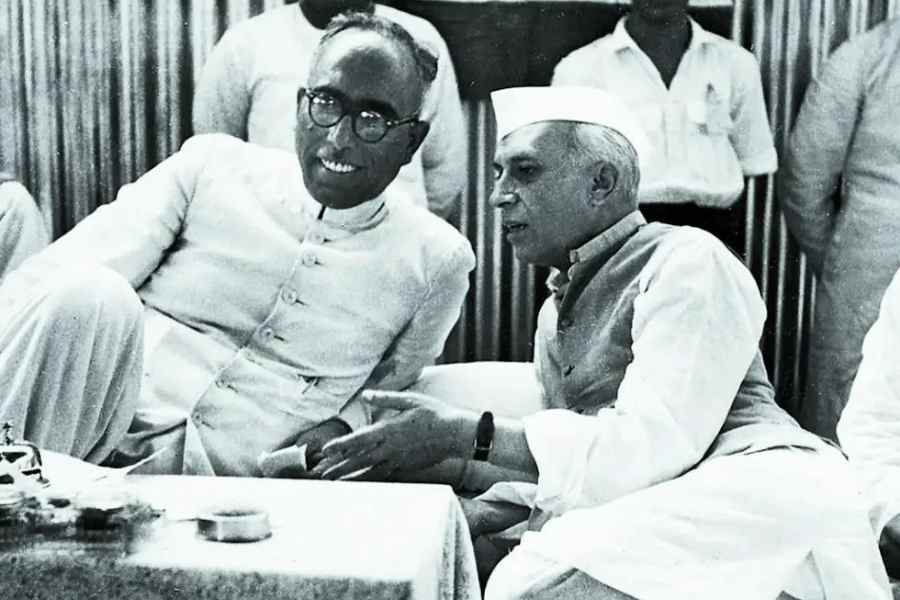SHEIKH ABDULLAH: THE CAGED LION OF KASHMIR
By Chitralekha Zutshi
Fourth Estate, Rs 799
Sheikh Abdullah (1905-1982) stood at the intersection of multiple contradictory forces, each of which overwhelmed him in the end. There was firstly the issue of how a major princely state adjoining India and Pakistan would navigate its way between the conflicting demands of each and, simultaneously, retain its own ambitions for substantial autonomy if not independence. For many Hindus in Jammu, Abdullah was a particularly demonic figure, someone who had convinced India’s leadership of his secular credentials but who represented, in fact, Islamic dominance if not bigotry. Finally, as a Muslim leader of what was to become India’s only Muslim-majority province, his relationship with the Indian National Congress would always be one of delicate balance. In his lifetime, he was to see himself transformed in the eyes of his core supporters from someone who was an icon of freedom to one who tarnished his reputation by compromising with principles. Chitralekha Zutshi’s biography ably traces this trajectory in the backdrop of the larger context of South Asian and Kashmir’s history.
By the 1930s, Abdullah was already a recognisable figure in Srinagar’s public life. Protests against the Dogra monarch led him to go to jail soon after returning to Kashmir on completing his education in Lahore and Aligarh. After his release, Abdullah established the All Jammu and Kashmir Muslim Conference in 1932. A strong presence in the nascent political life of the Kashmir Valley, it also owed much to Abdullah establishing himself in Srinagar’s most sacred spaces: Zutshi writes, “[he] wrestled control of a large portion of the shrines and mosques of the Valley from their religious leadership.”
Yet this success did not define the end state of Abdullah’s political and intellectual evolution. Most unusually, he sought to connect Kashmir and the struggle against the Dogras to a pan-India context. By 1939, the Muslim Conference had been renamed the National Conference much against the wishes of the Muslims of Jammu who split and retained the old Muslim Conference platform. Abdullah had also gone on to forge strong links with the Indian National Congress and a personal friendship with Jawaharlal Nehru. As communal polarisation grew in British India, it was reflected in the Muslim Conference in Jammu allying itself with the Muslim League and the National Conference in the Valley joining hands with the Congress. Abdullah was now riding a platform that included Islamic piety, Kashmir’s rights, social justice and secularism. The thesis that underwrites Zutshi’s book is that the mutual contradictions of these separate elements proved too difficult to manage even for as accomplished a politician as Abdullah.
The drama of the state’s accession to India is well-known. Abdullah played a critical role in consolidating what was in effect a partitioned state amidst communal massacres, ethnic cleansing and war with Pakistan. Zutshi insightfully shows how despite this, in many sections of the Congress, in India’s bureaucracy and in the media, residual suspicions regarding Abdullah’s loyalties remained and grew stronger.
His dismissal and then arrest in 1953 transformed him almost overnight in Pakistani eyes from being a renegade to a Kashmiri freedom-fighter. To many in the Valley, he, more than anyone else, represented Kashmiri autonomy and freedom. Abdullah now had to live up to the image of an anti-India firebrand, created for him as much by his supporters as his detractors. Zutshi argues how “this appropriation” of his image would “quite as much as his physical confinement, imprison Abdullah and limit his ability to maneuver.”
After almost two decades of being in and out of jail, change came in the 1970s with the transformation in South Asia’s geopolitics following the breakup of Pakistan. Secessionist sentiments in the Valley weakened and Abdullah realised that pragmatism required a change of tack. By February 1975, the Kashmir Accord had been signed and Abdullah found himself again at the helm of his state as chief minister. Ideas of plebiscite, self-determination or even autonomy were now in the past. Yet pragmatic politics also pointed to a direction Abdullah would remain hesitant about. In Zutshi’s words, “He was furious with himself for having compromised…”
Zutshi’s account casts Abdullah as a tragic figure because he was constantly in an impossible position — not Muslim enough for Pakistan and not secular enough for India. But his real tragedy was that “he failed to convince his own people, the Kashmiri Muslims, that he was sincere in his efforts to get the best deal for Kashmir given the circumstances.”
Like everything else on Kashmir, there is much that the discerning reader may disagree with in Zutshi’s account of Abdullah and Kashmir. Nevertheless, the book is a must-read for all those interested in understanding the tangled history of the Union territory and erstwhile state.










